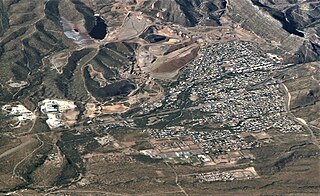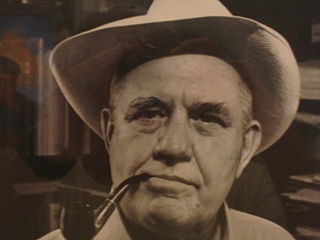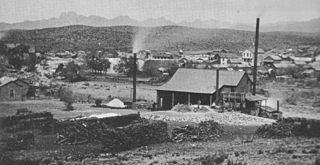The Naranjal mine (more commonly known as El Naranjal) is the name of a legendary lost gold mine in the Sierra Mountains of Mexico. Folklorist J. Frank Dobie devoted part of his book "Apache Gold and Yaqui Silver" to the story of this legendary lost gold mine.
The mine was supposedly located at the bottom of a canyon, beside a river and an abandoned hacienda. Surrounding the site were groves of oranges, hence the name El Naranjal, which means the orange grove in Spanish. Alternately, some legends point to orange-colored gold ore from the mine as a source of the name.
Unlike other lost or legendary mines in this area, there is little hard evidence it ever existed, and may be purely a legend, taken from garbled accounts of the far more popular legendary lost mines of Tayopa.

Superior is a town in Pinal County, Arizona, United States. Superior, which is in northern Pinal County, is the oldest town in that county. According to the 2020 census, the population of the town was 2,407. Superior was founded as a mining town for the Silver King and the later Magma mines; silver was mined at first, and then transitioned to copper. Currently, exploitation of the huge Resolution Copper deposit is being explored.

Mackenna's Gold is a 1969 American Western film directed by J. Lee Thompson, starring an ensemble cast featuring Gregory Peck, Omar Sharif, Telly Savalas, Ted Cassidy, Camilla Sparv and Julie Newmar in lead roles. It was photographed in Super Panavision 70 and Technicolor by Joseph MacDonald, with original music by Quincy Jones.

James Frank Dobie was an American folklorist, writer, and newspaper columnist best known for his many books depicting the richness and traditions of life in rural Texas during the days of the open range. He was known in his lifetime for his outspoken liberal views against Texas state politics, and he carried out a long, personal war against what he saw as braggart Texans, religious prejudice, restraints on individual liberty, and the mechanized world's assault on the human spirit. He was instrumental in saving the Texas Longhorn breed of cattle from extinction.

The Chino Mine, also known as the Santa Rita mine or Santa Rita del Cobre, is an open-pit porphyry copper mine located in the town of Santa Rita, New Mexico 15 miles (24 km) east of Silver City. The mine was started as the Chino Copper Company in 1909 by mining engineer John M. Sully and Spencer Penrose, and is currently owned and operated by Freeport-McMoRan Inc. subsidiaries. The area where the mine is located is at an average elevation of 5,699 feet (1,737 m).

The Lost Dutchman's Gold Mine is, according to legend, a rich gold mine hidden in the southwestern United States. The location is generally believed to be in the Superstition Mountains, near Apache Junction, east of Phoenix, Arizona. There have been many stories about how to find the mine, and each year people search for the mine. Some have died on the search.
Naranjal may refer to:

The Superstition Mountains is a range of mountains in Arizona located to the east of the Phoenix metropolitan area. They are anchored by Superstition Mountain, a large mountain that is a popular recreation destination for residents of the Phoenix, Arizona, area. They are roughly bounded by U.S. Route 60 on the south, Arizona State Route 88 on the northwest, and Arizona State Route 188 on the northeast.

A treasure map is a map that marks the location of buried treasure, a lost mine, a valuable secret or a hidden locale. More common in fiction than in reality, "pirate treasure maps" are often depicted in works of fiction as hand drawn and containing arcane clues for the characters to follow. Regardless of the term's literary use, anything that meets the broad definition of a "map" that describes the location of a "treasure" could appropriately be called a "treasure map."
The Peralta massacre was the alleged killing of a Mexican family by Apaches in about 1848. It is generally featured as an element of the legend of the Lost Dutchman's Gold Mine.

J. Frank Dobie High School is a public secondary school located in Houston, Texas. Founded in 1968, it is named after the Texas writer of the same name. It houses grades 10-12. A Ninth Grade Center was opened recently to help with the influx of students. It is the largest school in the Pasadena Independent School District. The school mascots are the Longhorns and the official colors are orange and black, similar to that of the University of Texas at Austin.
Tayopa is the name of a legendary lost silver mine in the Sierra Mountains of Mexico. Many stories, legends and myths surround it as well as articles and books describing the search for it. Folklorist J. Frank Dobie devoted part of his book "Apache Gold and Yaqui Silver" to the story of this legendary lost mine.
The Lost Adams Diggings are the subject of a Southwestern treasure story, dating to the early 1860s, that refers to the existence of a canyon rich in gold deposits somewhere in western New Mexico.

Thomas Calloway Lea III was an American muralist, illustrator, artist, war correspondent, novelist, and historian. The bulk of his art and literary works were about Texas, north-central Mexico, and his World War II experience in the South Pacific and Asia. Two of his most popular novels, The Brave Bulls and The Wonderful Country, are widely considered to be classics of southwestern American literature.
Coronado's Children (1930) was the second book written by J. Frank Dobie, published by The Southwest Press in 1930. It deals with lore of lost mines and lost treasures in the Southwestern United States, for the most part in Texas.

Pinal or Pinal City is a ghost town in Pinal County in the U.S. state of Arizona. The town was populated from the 1870s into the 1890s, in what was then the Arizona Territory.

The myth of the Seven Cities of Gold, also known as the Seven Cities of Cíbola, was popular in the 16th century and later featured in several works of popular culture. According to legend, the seven cities of gold referred to Aztec mythology revolving around the Pueblos of the Spanish Nuevo México, today's New Mexico and Southwestern United States.
Montezuma's treasure is a legendary buried treasure said to be located in the Casa Grande ruins or elsewhere in the Southwestern United States and Mexico. The legend is one of many treasure stories in American folklore. Thomas Penfield wrote, "There is not the slimmest thread of reality in this story which is common throughout Mexico and the southwestern United States. There are some puzzling aspects but the story, nevertheless, adds up to pure legend."

The Lost Nigger Gold Mine is a legendary mine in the folklore of the United States. According to the legend, in 1887 four brothers in Dryden, Texas—Frank, Jim, John, and Lee Reagan—hired an illiterate Seminole named William Kelly to help with work on their ranch. Kelly was known as "Nigger Bill" and has been identified as a cook and also as a horse wrangler; at the time of his employment by the Reagans, he was only 14. While working on the ranch, Kelly announced that he had discovered a gold mine, and was "greeted only with jeers". The next day he again tried to tell the Reagans about the mine, even going so far as to show them a lump of gold ore, but received a "cussing out" for his trouble.